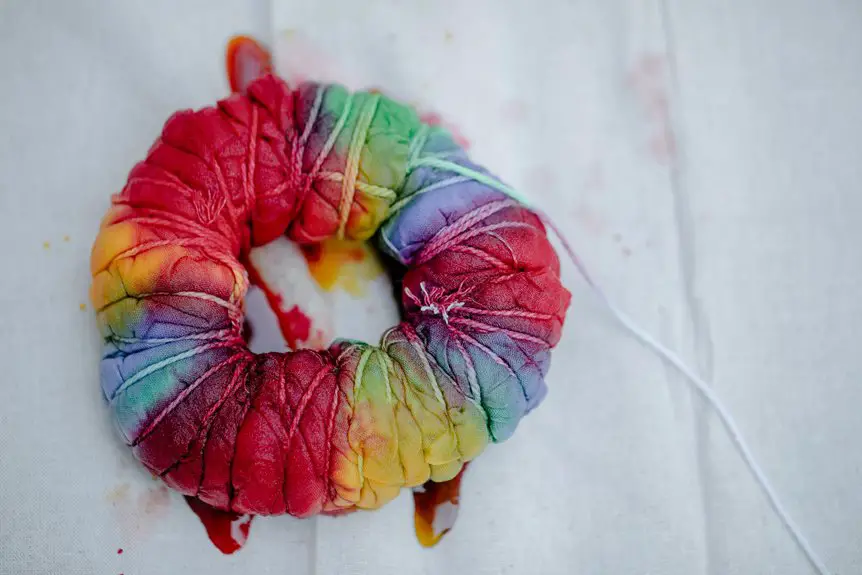To minimize fabric bleeding in tie-dye projects, start by choosing natural fibers like cotton or linen for better dye absorption. Always pre-wash your fabric to remove any chemicals that might interfere. Soaking your fabric in soda ash before dyeing helps the colors bond more effectively. Apply dye evenly and use techniques that prevent unwanted blending. Finally, proper post-dye care can enhance color vibrancy. Discover more tips to master your tie-dye technique and guarantee stunning results.
Table of Contents
Key Takeaways
- Pre-wash fabric to remove chemicals and dirt that can interfere with dye adherence and cause bleeding.
- Soak fabric in soda ash before dyeing to enhance dye penetration and bond securely.
- Use proper dye mixing techniques and follow manufacturer’s instructions for optimal dye-to-water ratios.
- Work with wet fabric for even dye distribution and apply colors side by side to prevent blending.
- Rinse dyed fabric in cold water immediately after dyeing and use a color fixative to lock in colors.
Choosing the Right Fabric for Tie-Dye
When you’re diving into tie-dye, choosing the right fabric is essential for achieving vibrant colors and minimizing bleeding.
Look for natural fibers like cotton, linen, or rayon, as they absorb dye better than synthetic materials. Cotton is particularly popular due to its affordability and wide availability.
Natural fibers like cotton, linen, and rayon absorb dye more effectively, making them ideal choices for vibrant tie-dye results.
Avoid fabrics with a high polyester content, as they can repel dye and lead to dull results. If you’re using a blend, guarantee it has a majority of natural fibers for the best outcome.
Also, consider the fabric’s weight; lighter fabrics tend to absorb dye more evenly, creating a brighter design.
Finally, always check the fabric’s care instructions to ensure it’s suitable for tie-dyeing, setting yourself up for dyeing success!
Importance of Pre-Washing Your Fabric
Pre-washing your fabric is an essential step that shouldn’t be overlooked. It removes any chemicals, sizing, or dirt that may interfere with the dyeing process. By washing your fabric before you start, you guarantee that the dye adheres better, resulting in more vibrant colors and less bleeding.
This step also helps to soften the fabric, making it easier to work with. Additionally, pre-washing allows you to test the fabric’s colorfastness. You’ll quickly see if the material loses color in the wash, giving you a chance to select a better option.
The Role of Soda Ash in Dye Bonding
Soda ash plays an essential role in how well your dye bonds to the fabric.
It not only enhances dye penetration but also greatly reduces color bleeding.
Enhancing Dye Penetration
To achieve vibrant and long-lasting colors in tie-dye, understanding the role of soda ash in dye bonding is essential. Soda ash acts as a fixative, helping the dye adhere to the fabric fibers, which enhances color penetration. When you pre-soak your fabric in a soda ash solution, it opens up the fibers, allowing the dye to bond more effectively. This process not only improves the intensity of the colors but also makes them more resilient to washing and fading.
| Benefit of Soda Ash | Emotional Impact |
|---|---|
| Enhances color vibrancy | Creates joy and excitement |
| Improves dye absorption | Fosters a sense of achievement |
| Increases wash durability | Builds confidence in your work |
| Prevents color fading | Evokes lasting memories |
| Elevates overall quality | Inspires creativity |
Reducing Color Bleeding
While achieving vibrant colors is a key goal in tie-dye, reducing color bleeding is equally important for maintaining the integrity of your designs.
One effective way to minimize color bleeding is by using soda ash, an essential ingredient in the dyeing process. When you soak your fabric in a soda ash solution before applying dye, it helps to fix the dye to the fibers.
Soda ash raises the pH level of the fabric, allowing the dye to bond more securely. This means colors won’t run together as easily, preserving your intended patterns.
Soaking Time Importance
Soaking your fabric in a soda ash solution for the right amount of time is key to achieving strong dye bonding. The soda ash helps the dye adhere better to the fibers, reducing the chances of bleeding. If you skimp on the soaking time, the dye may not bond properly, leading to unwanted color run.
| Soaking Time | Dye Bonding Strength | Recommended Fabric |
|---|---|---|
| 10 minutes | Weak | Cotton |
| 20 minutes | Moderate | Rayon |
| 30 minutes | Strong | Silk |
| 60 minutes | Very Strong | Linen |
Selecting the Proper Dye for Natural Fibers
How can you guarantee vibrant, long-lasting colors in your tie-dye projects? Choosing the right dye for natural fibers is essential.
Look for fiber-reactive dyes, as they bond chemically with the fabric, ensuring bright, enduring hues. Brands like Procion MX are excellent choices for cotton, linen, and rayon. They’re known for their strong colorfastness and minimal bleeding.
Before dyeing, always pre-wash your fabric to remove any finishes that could hinder dye absorption. You might also want to take into account dyes specifically labeled for natural fibers to maximize results.
Avoid using all-purpose dyes, as they tend to fade more quickly and bleed easily. With the right dye, you’ll create stunning, long-lasting designs that remain vibrant through washes.
Techniques for Even Dye Application
To achieve an even dye application, you need to focus on proper dye mixing and a consistent application technique.
Start by ensuring your dye is well-blended to avoid uneven colors.
Then, practice applying the dye evenly across the fabric to prevent bleeding and achieve a vibrant, uniform look.
Proper Dye Mixing
Achieving an even dye application starts with proper dye mixing, which can greatly reduce the risk of fabric bleeding.
Begin by following the dye manufacturer’s instructions closely, ensuring you use the correct ratios of dye to water. It’s essential to mix the dye thoroughly until there are no clumps or separation.
You might want to test your dye mixture on a scrap piece of fabric to see how it reacts before applying it to your project. If the color seems too intense, dilute it with more water.
Always remember to keep your dye solutions in separate containers to prevent accidental mixing. This careful approach helps you achieve vibrant, uniform colors while minimizing the potential for unwanted bleeding.
Consistent Application Technique
While applying dye, consistency is key to achieving even color distribution and minimizing bleeding. Start by using a squeeze bottle or spray bottle for precise application. As you apply the dye, maintain a steady pressure to guarantee an even flow.
Work in sections, focusing on one area at a time, and overlap slightly to avoid white spots. If you’re using multiple colors, apply them in a systematic order to prevent them from blending unintentionally. Keep your movements smooth and controlled; quick, erratic motions can lead to uneven saturation.
Finally, allow the dye to set properly, following the manufacturer’s instructions. This consistent technique won’t only enhance your design but also help prevent unwanted bleeding.
Post-Dye Rinsing and Washing Procedures
Once you’ve finished dyeing your fabric, rinsing it properly is crucial to prevent any unwanted bleeding. Start by rinsing the fabric in cold water to remove excess dye. Hold the fabric under running water, letting it flow until the water runs mostly clear. This process helps to wash away any loose dye particles that could transfer to other areas.
After rinsing, you can soak the fabric in a solution of water and a mild setting agent, like white vinegar or salt, to help set the colors. Once soaked for about 30 minutes, rinse again with cold water.
Finally, wash the fabric separately in cold water with a gentle detergent to guarantee all remaining dye is removed, safeguarding your vibrant designs.
Tips for Preventing Color Bleeding
To keep your tie-dye project vibrant and minimize color bleeding, start with the right fabric.
Choose materials that hold dye well and practice effective application techniques.
Finally, pay attention to post-dye care to guarantee your colors stay bright and beautiful.
Proper Fabric Selection
Choosing the right fabric is essential for preventing color bleeding in tie-dye projects. Opt for natural fibers like cotton or linen, which absorb dye better than synthetic materials. You’ll find that tightly woven fabrics hold dye more effectively, reducing the risk of bleeding. Avoid blends with polyester, as they can lead to uneven results.
Here’s a quick reference table for fabric selection:
| Fabric Type | Recommended? |
|---|---|
| Cotton | Yes |
| Linen | Yes |
| Rayon | Yes |
| Polyester Blend | No |
Effective Dye Application
After selecting the right fabric, the way you apply dye plays a significant role in minimizing color bleeding. First, work with wet fabric; this helps the dye spread evenly and reduces harsh edges.
Use squeeze bottles or spray bottles for controlled application, ensuring you avoid over-saturating any one area. When mixing colors, apply them side by side rather than overlapping to prevent unwanted blending.
Also, consider using a resist technique, like rubber bands or plastic wrap, to create defined patterns that keep colors separated.
Finally, don’t forget to apply dye in layers, allowing each layer to dry slightly before adding more. These techniques not only enhance your design but also help maintain the vibrancy of your colors.
Post-Dye Care Techniques
While the dyeing process is essential, post-dye care is equally important for preventing color bleeding.
First, rinse your fabric in cold water immediately after dyeing. This helps remove excess dye that hasn’t set.
Next, consider using a color fixative. Soaking your fabric in a vinegar solution can help lock in colors.
Afterward, wash your tie-dye in cold water with a mild detergent; avoid bleach or harsh chemicals.
When drying, opt for air drying rather than using a dryer, as heat can set any remaining excess dye.
Finally, always wash your tie-dye separately for the first few washes to prevent color transfer.
Long-Term Care for Tie-Dye Projects
To guarantee your tie-dye creations stay vibrant over time, you’ll need to adopt some thoughtful care practices.
Always wash your tie-dye in cold water to preserve the colors and minimize fading. Use a gentle detergent without bleach or harsh chemicals that can harm the dye.
When drying, opt for air drying instead of using a dryer, as heat can affect the vibrancy. If you need to iron your fabric, do it on the reverse side to prevent direct heat on the dye.
Store your tie-dye items in a cool, dry place away from direct sunlight, as UV rays can cause colors to fade.
Troubleshooting Common Bleeding Issues
If you notice colors running or bleeding in your tie-dye projects, it’s crucial to address the issue promptly to prevent permanent damage.
Start by identifying the source of the problem. Here are three common troubleshooting steps you can take:
- Rinse Immediately: If you catch bleeding early, rinse the fabric under cold water to remove excess dye before it sets.
- Use Color Fixatives: After rinsing, treat your fabric with a commercial color fixative to help lock in the dye and prevent further bleeding.
- Test Dye Compatibility: Verify that the dyes you’re using are compatible with your fabric type. Some dyes may not bond well, leading to bleeding.
Best Practices for Storing Tie-Dye Items
After addressing any bleeding issues, proper storage of your tie-dye items is essential to maintain their vibrant colors and prevent fading.
Start by washing your items with cold water and mild detergent to remove excess dye. Once dry, store them in a cool, dry place away from direct sunlight, as UV rays can dull colors.
Wash your tie-dye items in cold water with mild detergent, then store them away from sunlight to preserve their vibrant colors.
Use breathable cotton bags or bins rather than plastic, which can trap moisture and lead to mildew. If stacking, place tissue paper between items to avoid friction and color transfer.
Finally, label your storage containers to easily identify your creations. By following these practices, you’ll guarantee your tie-dye pieces stay bright and beautiful for years to come!
Frequently Asked Questions
Can I Use Synthetic Fabrics for Tie-Dye Projects?
Sure, you can tie-dye synthetic fabrics! Just remember, if you want vibrant colors, you might end up with a tie-dye masterpiece that resembles a toddler’s art project instead of a fashion statement. Good luck!
How Long Should I Soak Fabric in Soda Ash Solution?
You should soak your fabric in the soda ash solution for about 20 to 30 minutes. This guarantees better dye absorption, enhancing the vibrancy of your colors and helping to set the dye effectively.
What Types of Dyes Work Best for Cotton?
For cotton, fiber-reactive dyes work best. They bond with the fabric, ensuring vibrant colors that last. You’ll enjoy strong, long-lasting results when you choose these dyes for your cotton projects. Happy dyeing!
Can I Mix Different Dye Colors Together?
Mixing dye colors is like blending paint on a canvas; it creates unique shades. You can absolutely combine different colors, but be mindful of the results. Experiment and discover beautiful combinations that reflect your creative spirit!
Is It Safe to Iron Tie-Dye Items After Drying?
Yes, it’s safe to iron your tie-dye items after they’ve dried. Just use a low heat setting and place a cloth between the iron and fabric to prevent any damage or unwanted color transfer.
- Tetron Fabric for Marine Applications: Durability and Use Cases - June 18, 2025
- Tetron Fabric for Outdoor Furniture: Weather Resistance and Care - June 18, 2025
- Tetron Fabric for Wall Coverings: Style and Application Tips - June 18, 2025





